If you know anything about me (Rob, the creator of The Keys Explored) then you know that I love lighthouses and wildlife. And there are plenty of lighthouses in the Florida Keys to get even the most anti-hot weather person excited about visiting. The lighthouses in the Key are all very different and interesting, with several of them actually being at the center of wildlife preservation areas.
The lighthouses in the Florida Keys have played a crucial role in maritime navigation for centuries, guiding ships through the treacherous waters surrounding the coral reefs and islands of the Keys, even if there really have been a ridiculous number of shipwrecks here over the years. In our guide, we’ll take a look at each of the lighthouses in the Florida Keys, delving into their locations, accessibility, current status, a bit of history. If you have any questions about visiting the Keys or seeing lighthouses here, please leave a comment or send us a note. We’re always happy to share more!
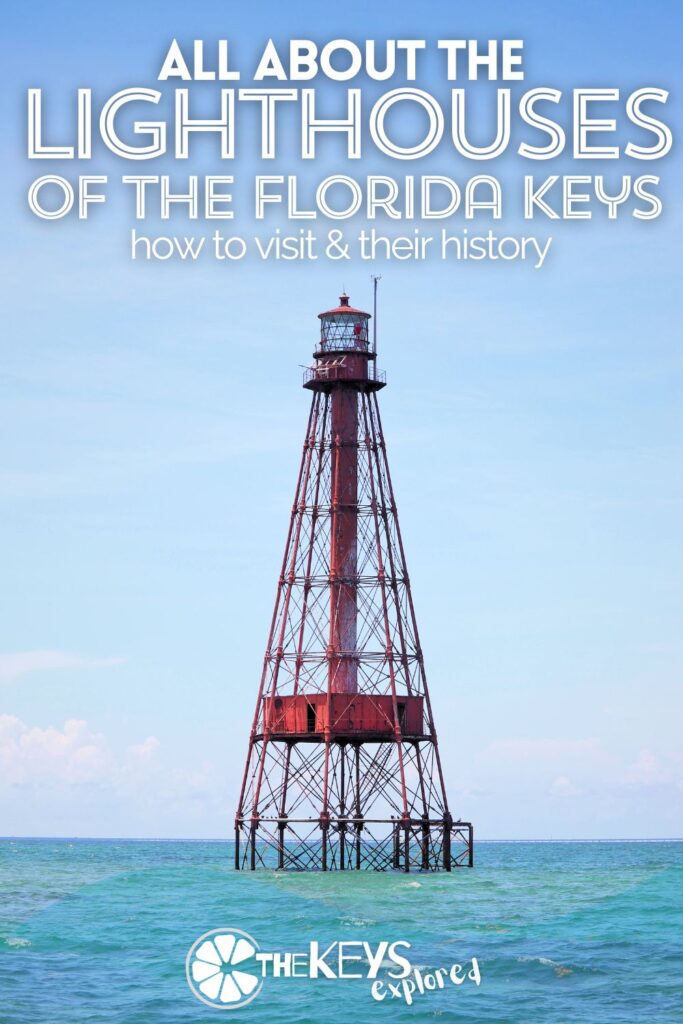
Florida Keys Lighthouses You can Visit
Who else loves to visit lighthouses and check out their museums and exhibits? I know it’s not just me. While there are nine lighthouses in the Florida Keys, you can actually only visit a few of them. These three lighthouses are all located at the end of the Keys, and two of them are actually in Dry Tortugas National Park. Take a look at these beautiful structures and see about adding them to your trip to the Keys.
Key West Lighthouse
The Key West Lighthouse holds a special place among the lighthouses of the Florida Keys as one of the few that is fully accessible to the public. Located in the heart of Key West very near the Hemingway Home and Audubon House, this historic lighthouse offers visitors a unique opportunity to climb to the top and enjoy panoramic views of the island and surrounding waters.
Built in 1848 to replace an earlier lighthouse destroyed by a hurricane, the Key West Lighthouse served as an important navigational aid for ships entering the Key West harbor for over 120 years. Today, it operates as the Key West Lighthouse and Keeper’s Quarters Museum, providing visitors with a glimpse into the life of lighthouse keepers and the maritime history of the Florida Keys, including the wreckers that Key West is known for.
When you visit, you can climb the 88 steps to the top of the lighthouse for views of Key West and the surrounding ocean. The restored keeper’s quarters house exhibits on the history of the lighthouse and its keepers, as well as artifacts related to maritime navigation in the Florida Keys, including really cool lenses.
Location: Key West on Whitehead Street
Date of Construction: 1848
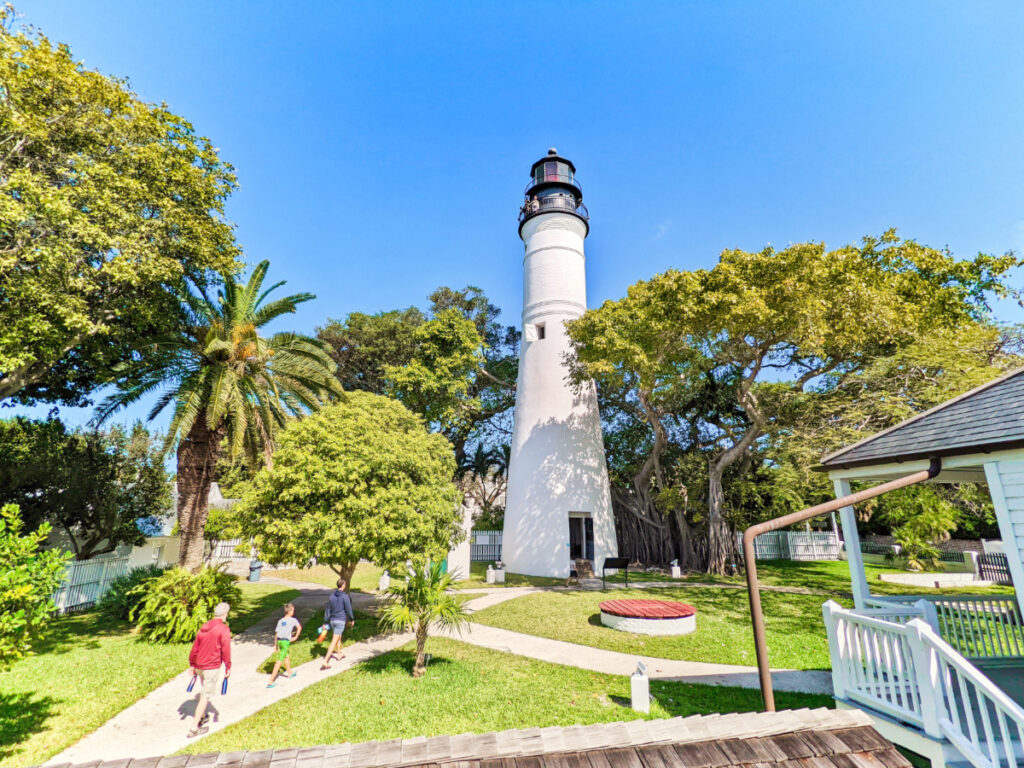
Tortugas Harbor Lighthouse
The Tortugas Harbor Lighthouse, located on Garden Key and build into Fort Jefferson, is in the remote Dry Tortugas National Park. Visitors get a unique glimpse into the army history of the Florida Keys and how these remote islands were used back then. Built in 1825, it’s one of the oldest lighthouses in Florida and was very important for guiding ships through the dangerous waters of the Dry Tortugas.
Unlike many of the offshore lighthouses in the Keys, the Tortugas Harbor Lighthouse is accessible to visitors if they can get out to the National Park. It’s located within the historic Fort Jefferson, a massive 19th-century coastal fortification that now serves as the centerpiece of Dry Tortugas National Park. When you come here, you can check out the lighthouse and the surrounding fort, learn about the intertwined military and maritime history and enjoy really great snorkeling along the moat wall and coal docks.
While no longer active as a navigational aid, the Tortugas Harbor Lighthouse remains an important historic landmark. Its location within the national park ensures its preservation, of which a refurbishment was recently completed (2021).
Location: Garden Key in Dry Tortugas National Park
Nearest Town: Key West (70 miles away)
Date of Construction: 1825
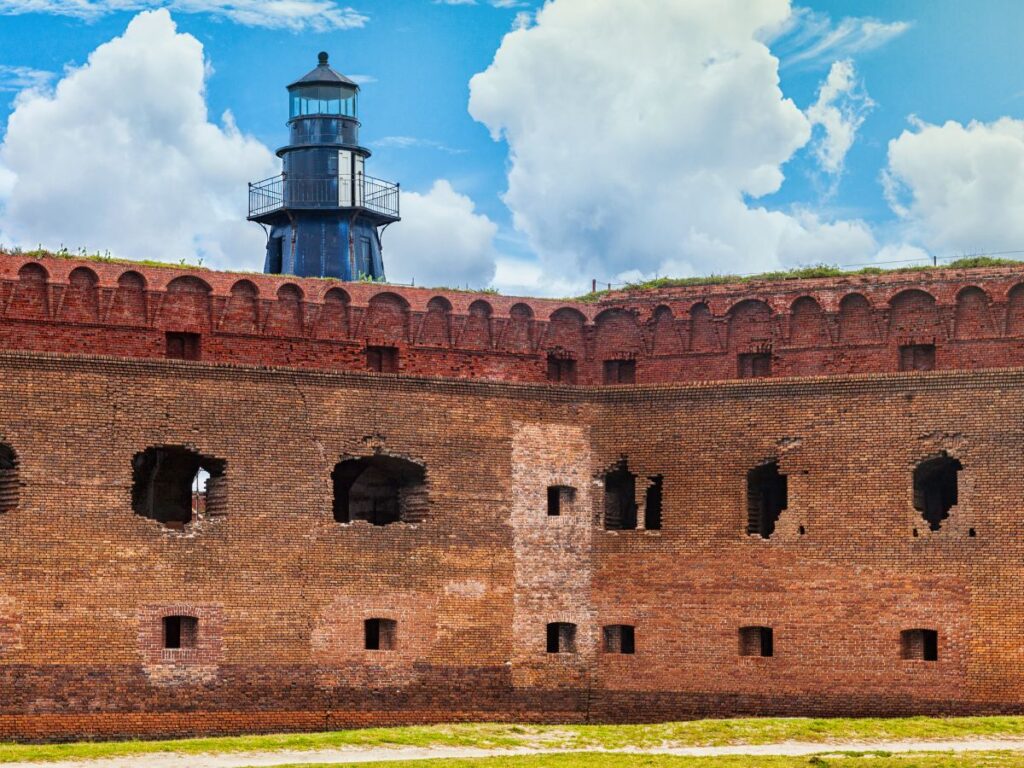
Dry Tortugas Lighthouse (Loggerhead Key Lighthouse)
The Dry Tortugas Lighthouse, also known as the Loggerhead Key Lighthouse, stands as the tallest lighthouse in the Florida Keys. Located on Loggerhead Key within Dry Tortugas National Park, this impressive brick structure continues to serve as an active aid to navigation, guiding ships through these remote waters. You cannot go up into the lighthouse, but you can visit Loggerhead Key if you have your own transportation (epic kayak trip or small boat).
Built in 1858, the lighthouse towers 157 feet above the surrounding landscape, making it visible for miles around. Its construction was a significant feat of engineering for its time, especially considering the remote location and the challenges of building on a small, isolated island.
While visitors to Dry Tortugas National Park can view the exterior of the lighthouse, the interior remains closed to the public. The surrounding waters and coral reefs of Loggerhead Key also offer excellent opportunities for snorkeling and diving, but are NOT a part of the Yankee Freedom catamaran out to the National Park. This has to be done through a private charter or if you own your own boat.
Location: Loggerhead Key in Dry Tortugas National Park
Nearest Town: Key West (approximately 70 miles away)
Date of Construction: 1858
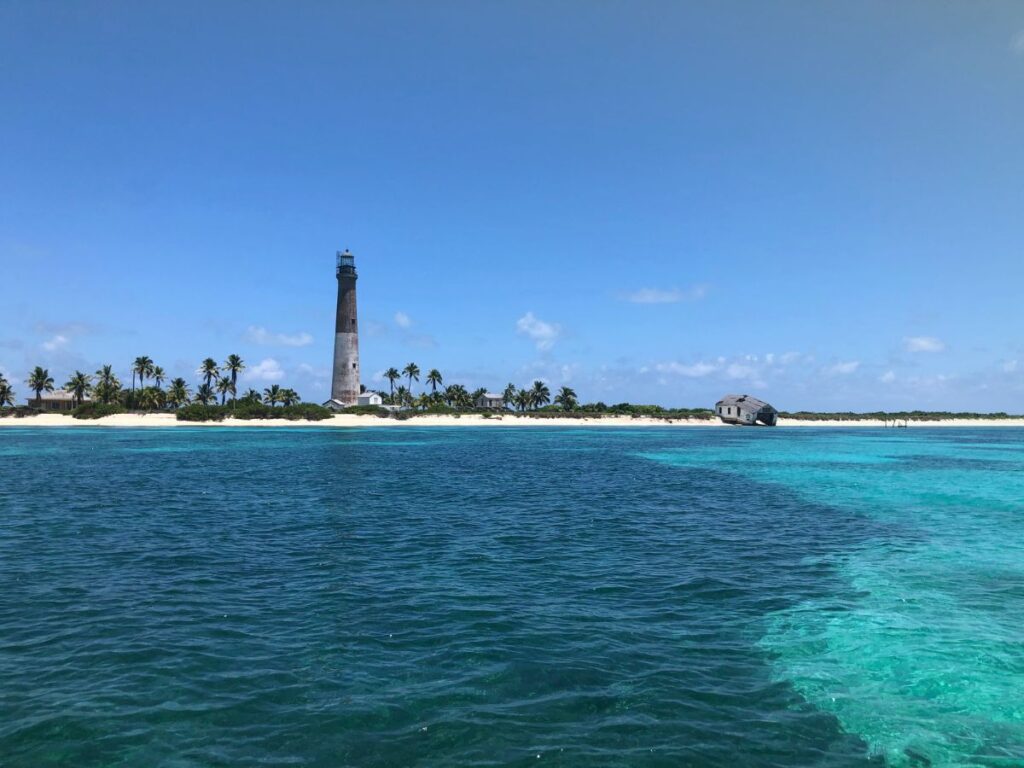
Snorkeling at Florida Keys Lighthouses
Although it’s not easy to visit the lighthouses in the Florida Keys, there is a really great option for a few of them: snorkeling!!! That’s right, you can do snorkeling tours to the reefs that are home to several of the lighthouses. We’ve got suggestions for how to get to each and what makes each of these iron beacons different.
Sombrero Key Lighthouse
The Sombrero Key Lighthouse, standing in shallow waters off the coast of Marathon, is another impressive example of 19th-century lighthouse engineering. This cast-iron, skeletal tower has been a familiar sight to mariners for over 160 years. I think it’s the coolest of the lighthouses in the Florida Keys.
While the lighthouse itself is not accessible to the public, the waters surrounding it are a popular spot for snorkeling and diving. The area is protected as part of the Florida Keys National Marine Sanctuary, which has helped preserve the vibrant coral reef ecosystem beneath the waves. Divers and snorkelers can explore this underwater wonderland, observing a diverse array of marine life while the lighthouse stands watch above. My favorite snorkeling tour, the Starfish Catamaran, leaves from Marathon to come here to the Sombrero Reef.
The lighthouse’s location on Sombrero Key, a submerged reef, made it a critical navigational aid for ships traversing the Florida Straits. Its construction in 1858 marked a significant improvement in maritime safety for the region.
Location: Offshore near Marathon
Date of Construction: 1858
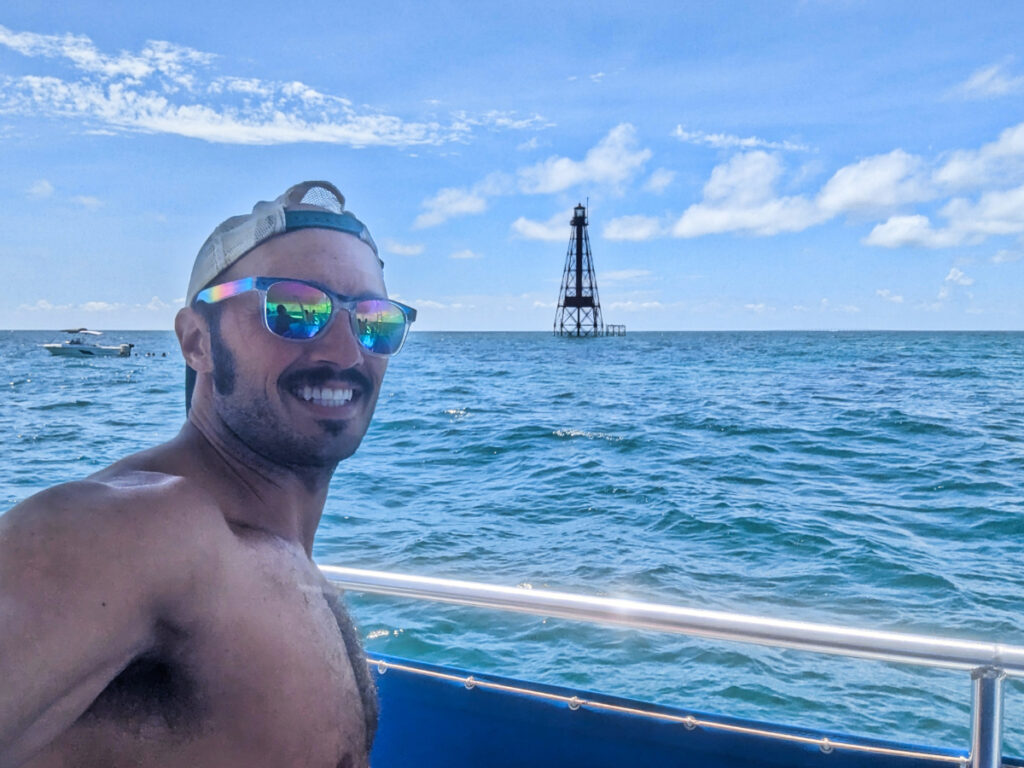
Alligator Reef Lighthouse
The Alligator Reef Lighthouse stands just off the coast of Islamorada, its white skeletal iron tower a familiar sight to locals and visitors alike. I think the paint job on the Alligator Reef Lighthouse is the coolest one in the Florida Keys. Named after the U.S. Navy schooner “Alligator,” which ran aground in the area in 1822, this lighthouse was constructed to prevent similar accidents and guide ships safely through the reef-laden waters.
Although decommissioned in 2015, the Alligator Reef Lighthouse continues to be a point of interest for those exploring the Florida Keys and snorkeling. While the structure itself is not accessible to the public, the surrounding waters are pretty great for snorkeling and diving. The area around the lighthouse is full of marine life, although it’s not as vibrant as Sombrero Reef. A lot of damage has been done to Alligator Reef due to boat owners anchoring on the reef during storms over the years.
The lighthouse’s design, typical of late 19th-century construction, features a skeletal iron tower painted white. This design allowed the structure to withstand the strong winds and waves of the Florida Keys while providing a clear visual marker for ships navigating the area.
Location: Offshore near Islamorada
Nearest Town: Islamorada
Date of Construction: 1873
Active Status: Decommissioned in 2015
Civilian Access: Not open to the public, but visible from the water
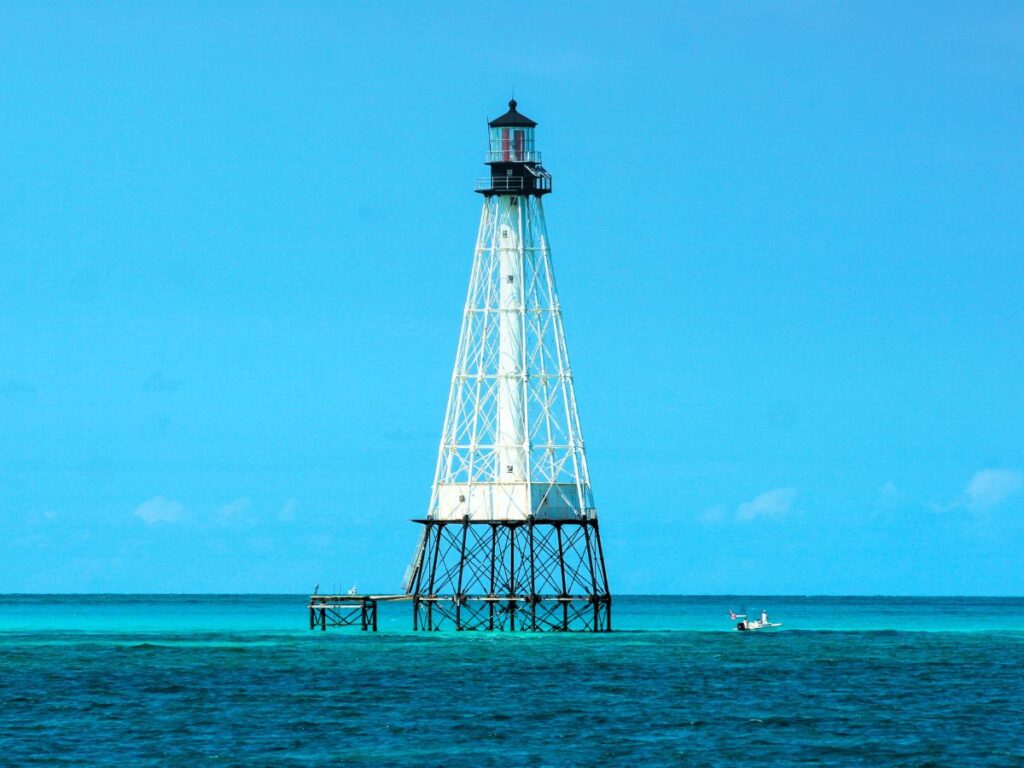
American Shoal Lighthouse
The American Shoal Lighthouse, with its distinctive red-painted iron frame, has been an iconic feature of the Florida Keys for over a century. Standing on a coral reef offshore just south of Sugarloaf Key, this skeletal tower lighthouse was built in 1880 because of the dangerous… you guessed it… shoals.
While the lighthouse itself is not open to the public, it can be viewed from boats passing through the area and some snorkeling tours go close to it. The waters around American Shoal Lighthouse are popular for divers since there are some deeper spots just next to the reef.
The lighthouse’s skeletal design is similar to that of the Sand Keys and Alligator Reef Lighthouses. This sort of design was very popular in the Florida Keys and was chosen for its ability to withstand hurricane-force winds while providing a clear visual marker for ships. There are a few other lighthouses on the Florida Gulf Coast with similar style as these ones.
Location: Offshore near Sugarloaf Key
Date of Construction: 1880
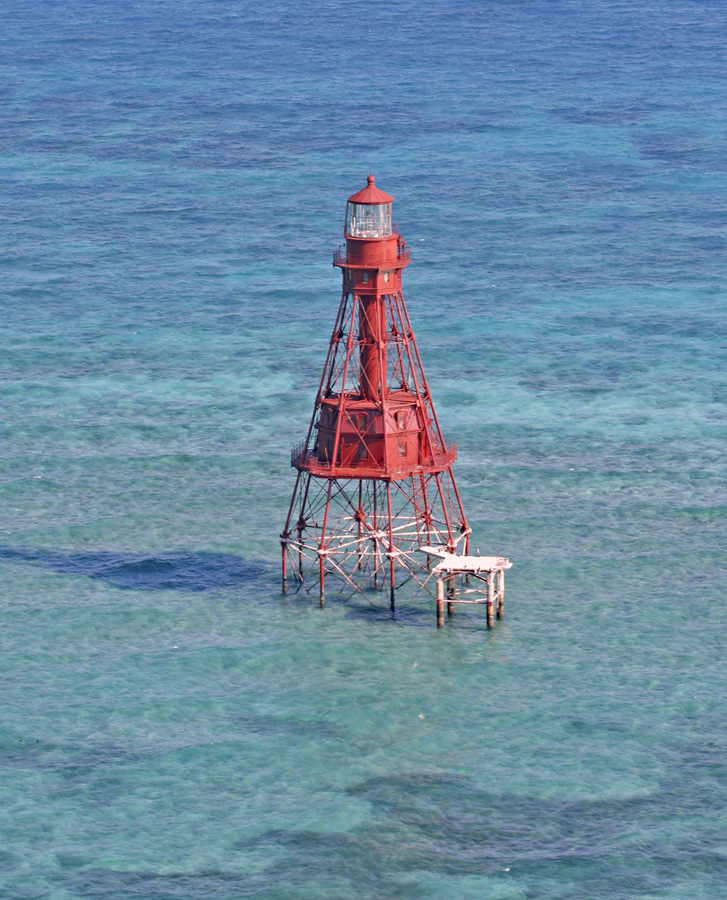
Sand Key Lighthouse
The Sand Key Lighthouse has a tumultuous history due to the challenges of building and maintaining lighthouses in the Florida Keys. The original brick structure, built in 1827, was destroyed by a hurricane in 1846. The current lighthouse, a skeletal tower similar to others in the Keys, was erected in 1853 to replace the destroyed structure.
Located on a submerged reef about seven miles southwest of Key West, Sand Key Lighthouse is a fun place to snorkel and the waters stay pretty calm. We enjoyed a great trip out here with Sunset Watersports from Key West and saw lots of barracuda and even a shark. The lighthouse is neat, but out here the Florida Keys wildlife is cooler.
While not open to the public, the waters surrounding Sand Key Lighthouse are popular for snorkeling and diving. The coral reef around the lighthouse supports a diverse ecosystem, offering visitors a chance to explore the natural beauty that the lighthouse was built to protect ships from.
Location: Offshore near Key West
Date of Construction: 1853 (current structure; original built in 1827)
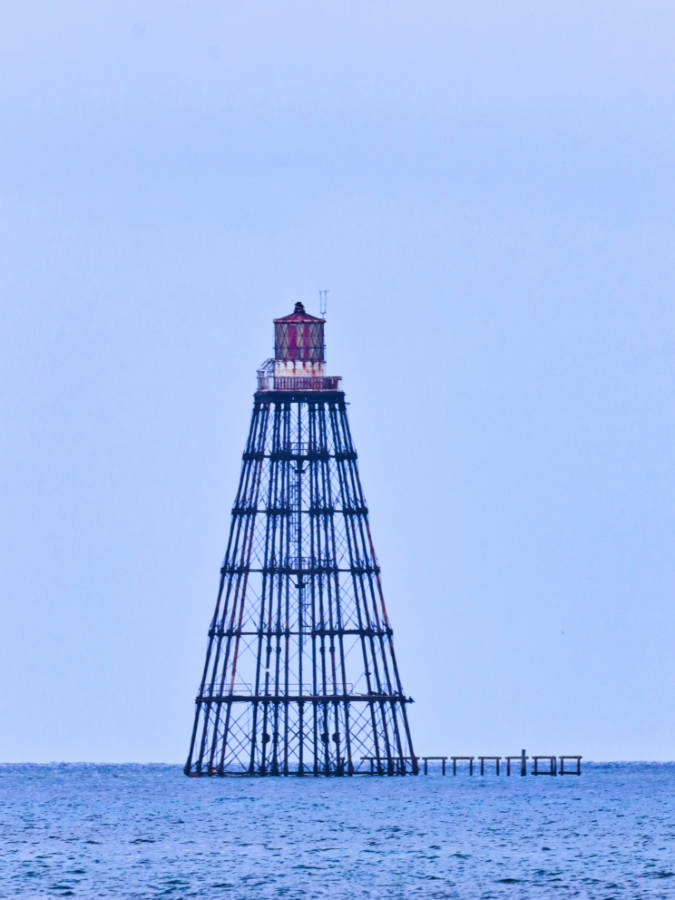
Lighthouses NEAR the Florida Keys
We’ve included a few lighthouses that are very close to the Florida Keys as well. The islands just north of the official Florida Keys are a continuation of the ancient reef system. These stretch into Biscayne National Park and towards Miami.
Boca Chita Key Lighthouse
The Boca Chita Key Lighthouse stands out among the lighthouses of the Florida Keys for its unique history and purpose. Unlike the other lighthouses we’ve discussed, this structure was never intended to serve as a navigational aid. Instead, it was built in the 1930s by industrialist Mark Honeywell as a decorative feature for his private island retreat and now today the lighthouse is part of Biscayne National Park and is open to the public.
Visitors can climb to the top of the 65-foot tower for panoramic views of the surrounding waters and islands of Biscayne Bay. The lighthouse and the island it stands on offer a peaceful retreat and a chance to experience the natural beauty of the Florida Keys.
Location: Boca Chita Key in Biscayne National Park
Nearest Town: Homestead
Date of Construction: 1930s
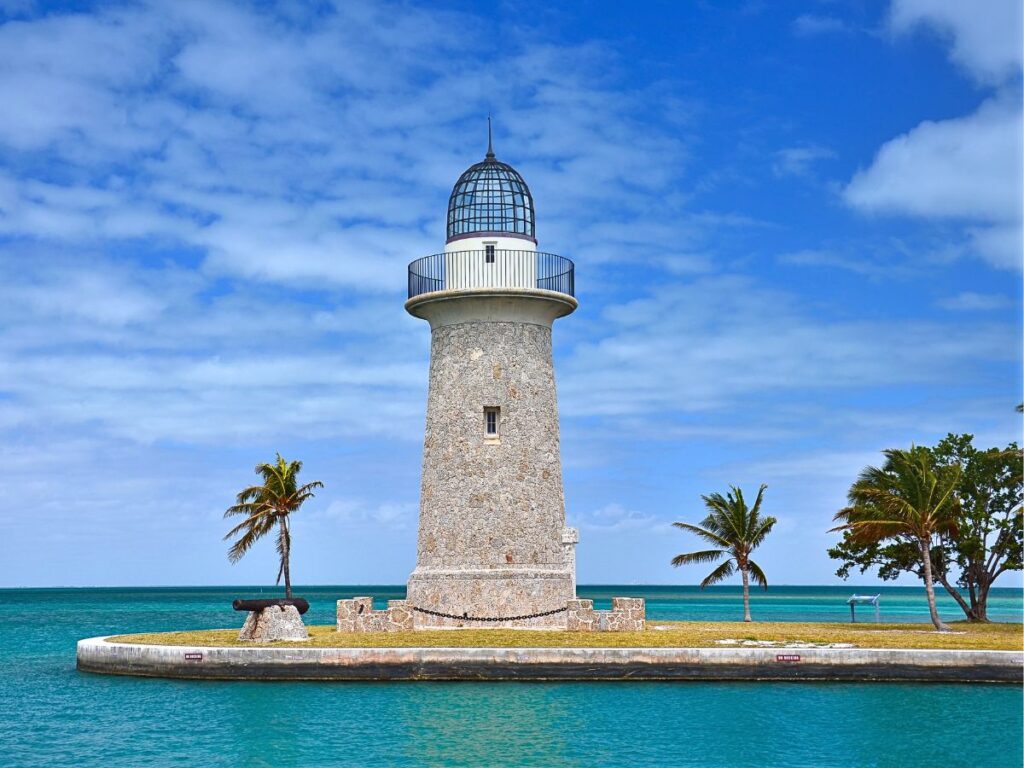
Carysfort Reef Lighthouse
The Carysfort Reef Lighthouse is one of the oldest existing lighthouses in the Florida Keys (but it’s basically far off, out of the main Keys area). Built in 1852, it was the first lighthouse in the United States to use a screw-pile design, which allowed it to be anchored directly into the coral reef (maybe not the most environmentally friendly option in retrospect).
Standing six miles off the coast of Key Largo, the Carysfort Reef Lighthouse played a crucial role in marking a particularly hazardous reef that had claimed numerous ships before its construction. The lighthouse’s distinctive red color makes it easily visible from a distance, serving as a clear warning to ships even after its decommissioning.
While the lighthouse itself is not open to the public, the surrounding Carysfort Reef is a popular destination if you want to take a tour from Key Largo. The waters around the lighthouse are part of the Florida Keys National Marine Sanctuary, protecting a diverse ecosystem of coral and marine life.
Location: Offshore near Key Largo
Date of Construction: 1852

Cape Florida Lighthouse
The Cape Florida Lighthouse, located on the southern tip of Key Biscayne in Miami-Dade County, Florida, is a historic beacon with a storied past. Constructed in 1825, it is the oldest standing structure in Miami-Dade County. The lighthouse was rebuilt in 1846 after being damaged during the Second Seminole War. Today, it stands at 95 feet tall and is a prominent feature within Bill Baggs Cape Florida State Park.
Civilians can visit the lighthouse, which offers guided tours and panoramic views of the Atlantic Ocean and Biscayne Bay from its observation deck. Although the lighthouse is no longer an active navigational aid, it remains a significant historical landmark and a favorite destination for history buffs and nature enthusiasts. The nearest city to the Cape Florida Lighthouse is Miami, which is about 12 miles away.
Location: Bill Baggs Cape Florida State Park, Miami
Date of Construction: 1825
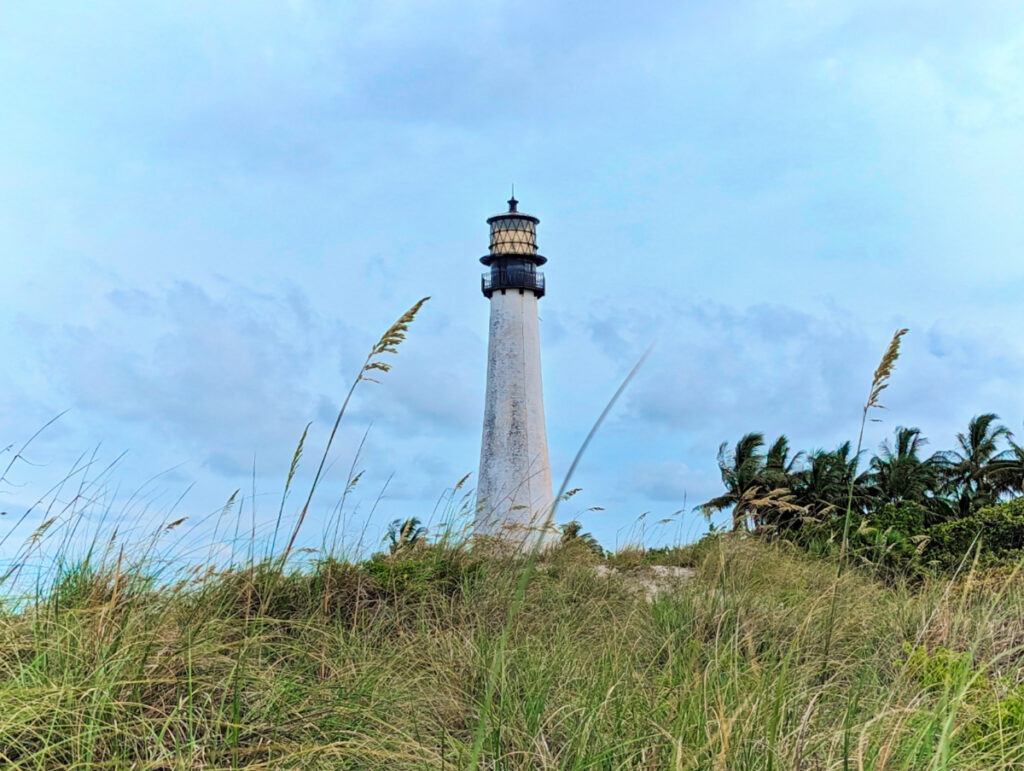
Fowey Rocks Lighthouse
Another lighthouse located in Biscayne National Park, Fowey Rocks Lighthouse is located approximately seven miles southeast of Key Biscayne, Florida, within the Florida Keys National Marine Sanctuary. Built in 1878, this offshore lighthouse was designed to replace the Cape Florida Lighthouse as a navigational aid, warning ships of the dangerous coral reefs in the area.
The lighthouse is a skeletal cast-iron structure rising 110 feet above the water, with a unique octagonal design. Unlike Cape Florida Lighthouse, Fowey Rocks is not accessible to the public due to its offshore location, and it can only be viewed from a boat or during snorkeling and diving excursions in the surrounding waters. The lighthouse remains active, using an automated light system to guide vessels around the coral reef. The nearest mainland city to Fowey Rocks is also Miami, making it a notable landmark in the region’s maritime history.
Location: Bay of Biscayne
Date of Construction: 1878
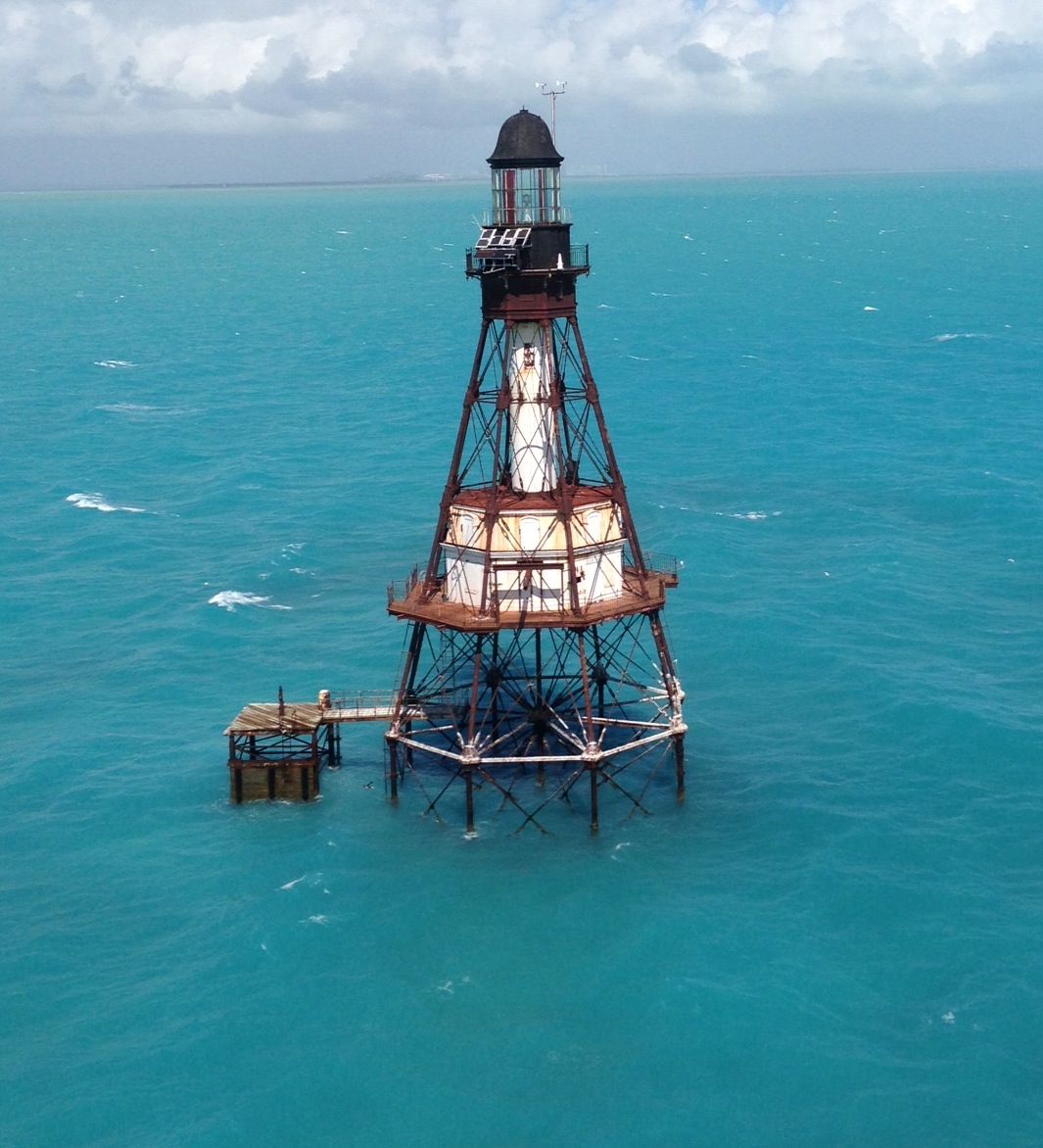
So did my obsession with lighthouses rub off on you? The lighthouses of the Florida Keys are so cool and different from the lighthouses in Maine or the super tall St Augustine Lighthouse. Down here we’re weathered, tropical and beautiful no matter how rusty or seemingly inaccessible.
If you have any questions about visiting the lighthouses or are looking for a good snorkeling tour to get closer to some of them, please leave a comment or send us a note. We’re always happy to share more and help you plan a great trip to explore the Florida Keys!
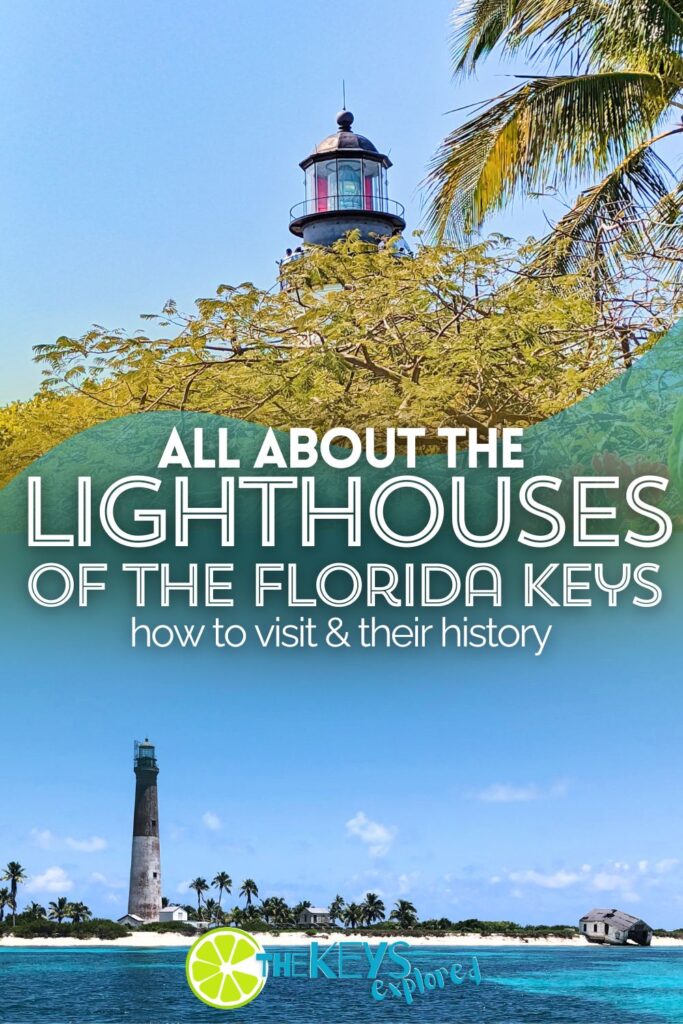


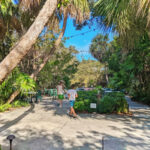
Pingback: Historic Sites, Parks and Museums in the Middle Keys - The Keys Explored